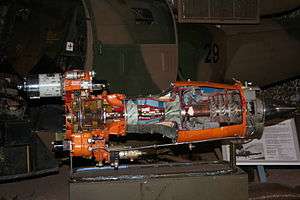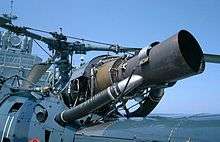Turbomeca Artouste
The Turbomeca Artouste is an early French turboshaft engine, first run in 1947. Originally conceived as an auxiliary power unit (APU), it was soon adapted to aircraft propulsion, and found a niche as a powerplant for turboshaft-driven helicopters in the 1950s. Artoustes were licence-built by Bristol Siddeley (formerly Blackburn) in the UK, Hindustan Aeronautics Limited in India, and developed by Continental CAE in the US as the Continental T51. Power is typically in the 300 kW (400 hp) range.
| Artouste | |
|---|---|
 | |
| Turbomeca Artouste IIIB | |
| Type | Turboshaft |
| National origin | France |
| Manufacturer | Turbomeca |
| First run | 1947 |
| Major applications | Aérospatiale Alouette II Aérospatiale Alouette III |
| Developed into | Continental T51 |
Variants
- Artouste I
- Artouste II
- Artouste IIB
- Artouste IIC
- 373 kW (500 hp)[1]
- Artouste IIC-5
- Artouste IIC-6
- Artouste IIIB
- 410 kW (550 hp)[1]
- Artouste IIID
- Continental T51
- Licence production and development of the Artouste in the United States
- Turbomeca Marcadau
- A turboprop variant, the Marcadau was a development of the Artouste II, producing 300 kW (402 hp) through a 2.3:1 reduction gearbox.
Applications
- Artouste
- Aérospatiale Alouette II
- Aérospatiale Alouette III
- Aerospatiale Lama
- Aerotécnica AC-14
- Atlas XH-1 Alpha
- Handley Page Victor - as APU
- Hawker Siddeley Trident - as APU
- IAR 316
- IAR 317
- Nord Norelfe
- Piasecki VZ-8 Airgeep
- SNCASO Farfadet
- Vickers VC10 - as APU
- Marcadau
Engines on display
A Turbomeca Artouste is on public display at:
- The Helicopter Museum (Weston)
- Aviodrome - Lelystad Airport - The Netherlands
Specifications (Artouste IIIB)

Turbomeca Artouste on an Alouette III
Data from Aircraft engines of the World 1970[2]
General characteristics
- Type: Turboshaft
- Length: 1,815 mm (71.5 in)
- Diameter: ~450 mm (18 in) (casing)
- Width: 507 mm (20.0 in)
- Height: 627 mm (24.7 in)
- Dry weight: 154 kg (340 lb)
Components
- Compressor: 1-stage axial + 1-stage centrifugal
- Combustors: Annular combustion chamber
- Turbine: 3-stage turbine
- Fuel type: Aviation Kerosene, such as Jet A, Jet A-1 or JP-4
- Oil system: Pressure spray at 4.6 bar (66 psi) with return
Performance
- Maximum power output:
- Take-off power: 437 kW (586 shp) (equivalent) (410 kW (550 shp) + 0.39 kN (88 lbf)) at 33,500 rpm, de-rated
- Maximum continuous power: 437 kW (586 shp) (equivalent) (410 kW (550 shp) + 0.39 kN (88 lbf)) at 33,500 rpm, to 5,000 m (16,000 ft)
- Take-off power: 437 kW (586 shp) (equivalent) (410 kW (550 shp) + 0.39 kN (88 lbf)) at 33,500 rpm, de-rated
- Overall pressure ratio: 5.2:1
- Air mass flow: 4.3 kg/s (9.5 lb/s)
- Turbine inlet temperature: JPT 773 K (500 °C) at 33,500 rpm
- Specific fuel consumption: 0.46 kg/kW/h (0.76 lb/shp/h) (equivalent)
- Power-to-weight ratio: 2.84 kW/kg (1.73 shp/lb) (equivalent)
gollark: I may have a lead on the recipe dumps.
gollark: In this case it's kind of justified because it needs to pull in dwarf fortress, but still.
gollark: Go is supposed to not *need* docker anyway due to the crazy static binaries thing.
gollark: Oh, and gone through the manual again.
gollark: It did make it very convenient, *after* I had packed my server with several hundred megabytes of junk and waited ages.
References
| Wikimedia Commons has media related to Turbomeca Artouste. |
- Notes
- Taylor, John W.R. FRHistS. ARAeS (1962). Jane's All the World's Aircraft 1962-63. London: Sampson, Low, Marston & Co Ltd.
- Wilkinson, Paul H. (1970). Aircraft engines of the World 1970 (21st ed.). Washington D.C.: Paul H. Wilkinson. p. 178.
- Bibliography
- Taylor, John W.R. FRHistS. ARAeS (1962). Jane's All the World's Aircraft 1962-63. London: Sampson, Low, Marston & Co Ltd.
- Gunston, Bill (1986). World Encyclopedia of Aero Engines. Wellingborough: Patrick Stephens. p. 163.
This article is issued from Wikipedia. The text is licensed under Creative Commons - Attribution - Sharealike. Additional terms may apply for the media files.